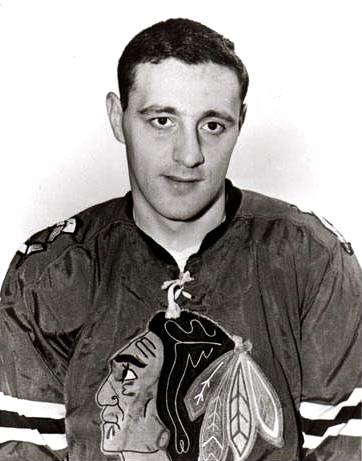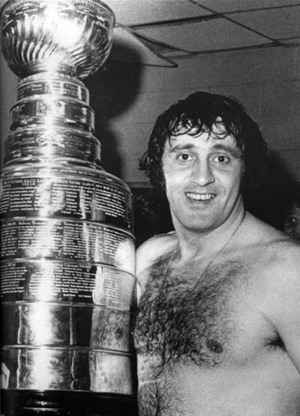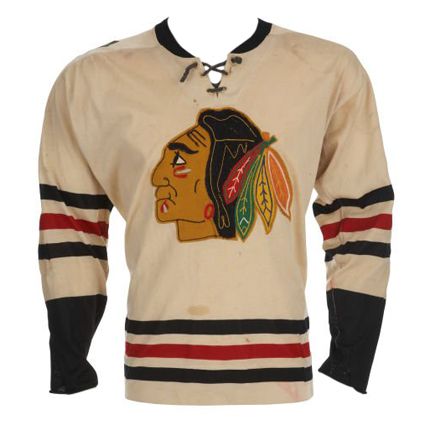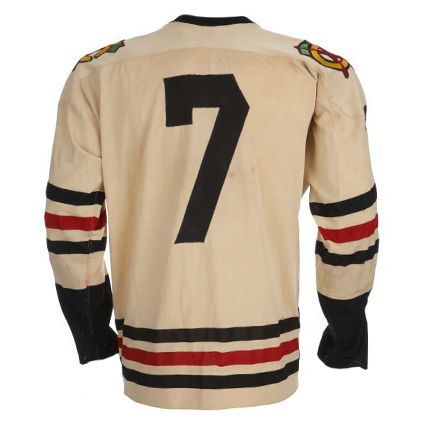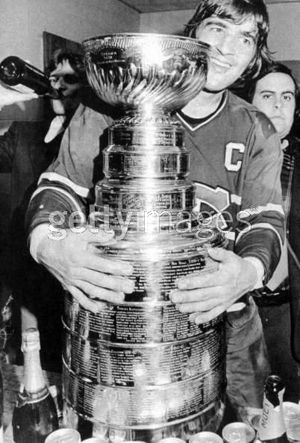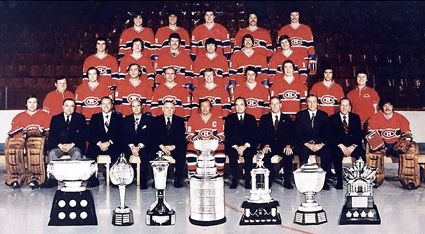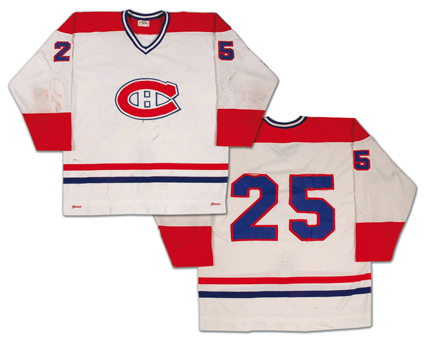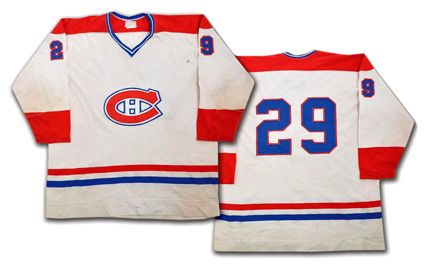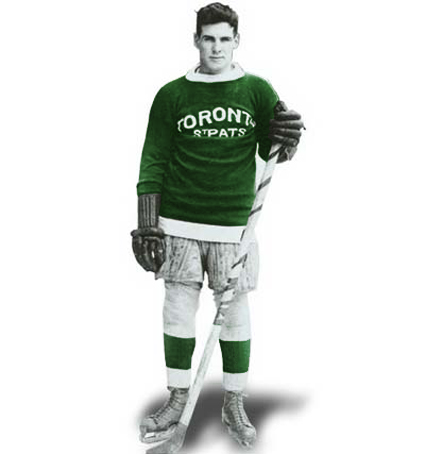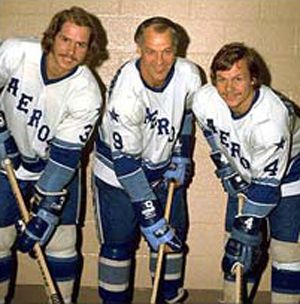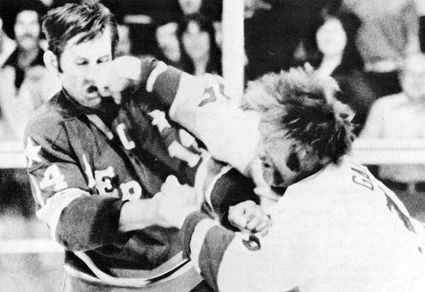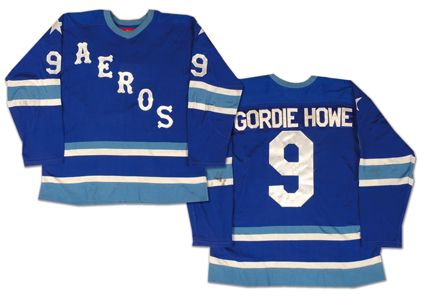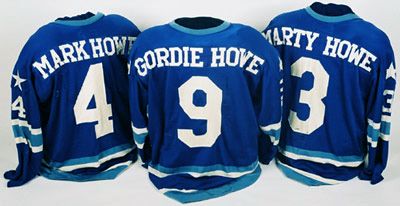It was quite a season. For the first time in history, the Hawks finished first. I had 21 goals, but a big fat zero in six playoff games as we got knocked out in the opening round. I knew that Roger wasn't impressed with me as a playoff performer. Still, in three seasons with Chicago I had scored 23, 27 and 21 goals. So what happened? I was traded to Boston. A last place club.For the first time in my hockey life I had been rejected. Guys talk about trades being part of the game. I suupose it's always in the back of your mind if you're a professional athlete. But when it happens - pow. It's a slap in the face. What it means to a guy is that someone doesn't think enough of him to keep him around. That was my reaction anyway. Maybe if you go from a bad club to a winner you're thrilled. But Boston? That was a last place team. They hadn't been in the playoffs since 1959. It was like the guys on the Hawks were consoling me at a wake. "You'll like it in Boston," they said. "It's a great hockey town." That wasn't my reaction, though. Ther was shame. I had scored 71 goals in three years, and my club thought they were getting someone better. Funny, isn't it, that the first thing you ask when you're told you've been traded is: "Who did they trade me for?" Then when you find out the guy's name, you try to reationalize that he's really pretty good, maybe even a bigger name than you are. Every guy I know who's ever been traded want's to know; "Who'd they get for me?"Yet, there was something positive about the Boston deal. For the first time I realized I was a celebrity. I never thought people knew my name or that the papers cared much about me. But when the trade was announced, I was the major figure in the deal. The Hawks had to get rid of me before I saw my name in big type. At Chicago I'd been overshadowed by Bobby Hull, Stan Mikita, Glenn Hall, Ken Warrham. All of a sudden, I was a big man in Boston. Together with Orr. And I liked that.
Saturday, May 15, 2010
1963-64 Chicago Black Hawks Phil Esposito Jersey
On this date in 1967, the course of NHL history was changed for the next ten years when the Chicago Black Hawks dealt Phil Esposito, Ken Hodge and Fred Stanfield to the Boston Bruins for Gilles Marotte, Pit Martin and Jack Norris in what is considered one of the most lopsided trades in league history.
Left Wing Stanfield had been with the Black Hawks for three seasons, but saw his number of games with the Black Hawks decline from 58 as a rookie in 1964-65 to 39 to just 10 in 1966-67.
Right Wing Hodge had just completed his second season and had come off of a 10 goal, 35 point campaign.
Center Esposito first played 27 games with Chicago in 1963-64, although he gave little hint as to what was to come when he scored a mere 3 goals and 2 assists for just 5 points. The following three seasons he became a full-season NHL regular, scoring 55, 53 and finally 61 points with a high of 27 goals in 1965-66.
In exchange for those three players, the Black Hawks received Marotte, a defenseman with two seasons under his belt, goaltending prospect Norris, a player who played 23 games with Boston in 1964-65, and Martin, the second leading scorer for Boston the previous season, but with just 42 points.
Following the trade Norris would play just 10 games in goal for the Black Hawks over the next two seasons before moving to the Los Angeles Kings after a season in the minors. Marotte saw action for Chicago for three seasons before also moving on to the Kings. Martin was the bright spot in the trade for the Black Hawks, as he played ten years for Chicago, averaging 63 points per season with a high of 90 in 1972-73 and leading the team in scoring once in 1976.
In the ten years following the trade, Chicago would qualify for the playoffs nine times, reaching the finals twice, losing to the Montreal Canadiens twice, by one goal in the seventh game in 1971 and in six games in 1973.
In the years following the trade, Stanfield was a member of the Bruins for six seasons, averaging 68 points and an incredibly consistent 22.5 goals, with each season falling between 20 and 25 goals.
Hodge shown brightly in Boston, playing nine seasons with the Bruins, with remarkable durability, only once playing less than 70 games, and scoring 90 points or more on three occasions. 1973-74 was his best season, scoring 50 goals and 105 points.
It was the arrival of Esposito, admittedly along with the maturation of defenseman Bobby Orr, that transformed the Bruins. Prior to Esposito's arrival in Boston, the Bruins had missed the playoffs in the six team NHL the previous eight seasons. Following the trade with Chicago, Boston would go on a run of making the playoffs for 29 straight years.
From Esposito's 1972 book "Hockey is My Life":
Esposito would immediately surpass his career high 61 points with Chicago and lead the Bruins in scoring with 84. Paired with Hodge and Ron Murphy in 1968-69, the line would explode offensively, setting a record for points by a line with Esposito's 126 points leading the league in scoring and obliterating the NHL single season record in the process, as he became the first player to ever reach 100 points in a season.
The 1969-70 season featured Orr winning the scoring title with Esposito second with 99 points as the Bruins won their first Stanley Cup since 1941 thanks in part to Esposito scoring 27 points from 13 goals and 14 assists in just 14 games.
Phil Esposito with the Stanley Cup in 1970
Dozens of scoring records fell to the Bruins the following season as Esposito upped the scoring record to 152 points and the goal scoring mark to 76. Remarkably, Esposito and Orr with 139 points, Johnny Bucyk with 116 and Hodge with 105, finished 1-2-3-4 in league scoring, something no NHL teammates had ever done before. Hodge's 105 points were a record for right wings and Orr's 139 still stands as the record for defensemen.
Esposito would again win the league scoring title in 1971-72 with 133 points, with Orr again second as the Bruins won their second Stanley Cup in three years. During the playoffs that season Esposito was again a major contributor, scoring nine goals and 15 assists for 24 points in 15 games.
The Stanley Cup Champion 1971-72 Boston Bruins
Another scoring title for Esposito was in store for 1972-73, this time with 55 goals and 133 points with Hodge and Stanfield fourth and fifth for the Bruins.
The Bruins offense again reached the point of domination again in 1973-74 with Esposito's fifth scoring title, and fourth consecutive, when he scored 68 goals and 145 points. Once more, Esposito, Orr (122 points) and Esposito's linemates Hodge (105) and Wayne Cashman (89) swept the top four places in the scoring race, the only other time in league history teammates have swept the top four places, as the Bruins made it all the way to the Stanley Cup Finals.
Esposito lost out on the scoring title to Orr (135 points) in 1974-75, but still came in second overall with 127 points while leading the league in goal scoring with 61, his fifth consecutive season with 55 goals or more.
12 games into the 1975-76 season, the Bruins dealt Esposito to the New York Rangers, with Hodge following him there a year later, closing the most successful chapter in Boston Bruins history.
Esposito was inducted into the Hockey Hall of Fame in 1984 and Boston retired Esposito's sweater #7 in a memorable ceremony in 1987.
While a member of the Bruins, Esposito won five Art Ross Trophies, two Hart Trophies, two Lester Pearson Awards, and two Stanley Cups, as did Hodge while Stanfield captured one.
The Chicago Blackhawks still have yet to win another Stanley Cup.
Today's featured jersey is a 1963-64 Chicago Black Hawks Phil Esposito jersey, as worn in Esposito's rookie season with Chicago. This was the first year for this exact style of Black Hawks jersey with three stripes on the sleeves and would be used for just two seasons before the lace up collar would be discontinued.
While we try to avoid YouTube slideshows in favor of video footage, every now and then we find one that does a pretty nice job. Perhaps it was the music that tipped the scales in favor of this look at the career of Phil Esposito.
Another great video moment from YouTube, Phil Esposito, along with basketball star Bill Walton and football legend Dick Butkus, on the game show, "Wheel of Fortune"!
Labels:
Boston Bruins,
Chicago Blackhawks,
Esposito Phil
Friday, May 14, 2010
1976-77 Montreal Canadiens Jacques Lemaire Jersey
On this date in 1977 the Montreal Canadiens successfully completed the finest season in NHL history when Jacques Lemaire scored his second goal of the game at 4:32 of overtime to give the Canadiens a 2-1 win in Game 4 of the Stanley Cup Finals, sweeping the Boston Bruins to capture their 20th Stanley Cup championship.
During the regular season, Montreal scored 387 goals while allowing just 171, outscoring their opponents by 216 goals, an average margin of victory of 2.7 goals per game. They shutout their opponents 14 times and scored seven or more goals 18 times, including a high of 11 twice, with a 11-0 win over the Capitals providing their largest margin of victory.
Here are brief highlights of Game 4 of the 1977 Stanley Cup Finals, followed by an extended version which shows much of the overtime as well as the presentation of the Stanley Cup to Canadiens Captain Serge Savard.
The Canadiens season began on October 7, 1976 with a 10-1 win over the Pittsburgh Penguins, setting the tone for what would become the most dominant season in NHL history. Another win was followed by their first loss at Buffalo. Three more wins and a loss at Boston were followed by four wins and a tie to put Montreal at 9-2-1 after 12 games. A loss to Boston, their only home loss of the season, was followed by a seven game unbeaten streak, putting the Canadiens at 14-3-3 at the quarter mark of the season.
A 1-0 loss to the Toronto Maple Leafs was followed by five wins as part of a ten game unbeaten streak. After losing to the New York Rangers they went on a new 11 game unbeaten streak to reach 32-5-6.
A loss to the St. Louis Blues, a win at the Los Angeles Kings and another loss to Boston on January 17th, their third loss of the season to the Bruins, sent Montreal on an amazing run to finish out the regular season.
Over the next 34 games, from January 18th to April 3rd, Montreal would lose just once more. A 21 game unbeaten streak (17 wins, including a season high eight game winning streak, and four ties) was stopped by a loss at Buffalo. A tie with Toronto preceeded another eight game winning streak as part of a 12 game unbeaten streak to close out the season and finish at 60-8-12, setting an NHL record with 132 points which still stands today.
Steve Shutt led the team, and the league, in goals with 60, while Guy Lafleur was second on the team and in the league with 56. Additionally, Lafleur led the league in assists with 80 and points with 136 to win the scoring title by 14 points over Marcel Dionne. Shutt came in third with 105 points, the only other player to top 100.
In all, eight Canadiens scored more than 20 goals each and another six had more than a dozen.
Once in the playoffs, Montreal swept St. Louis in four, outscoring the Blues 19-4, beat the up and coming New York Islanders four games to two and then beat Boston in the finals 7-3 and 3-0 at Montreal before winning in Boston 4-2 and 2-1 in overtime to complete their finest season in the history of the franchise, dating back to 1909. The Stanley Cup was not only the 20th for the franchise, but the second of four consecutive from 1976 to 1979.
The club also dominated the post-season awards, with Dryden and Larocque sharing the Vezina Trophy, Larry Robinson taking the Norris Trophy and Lafleur having a season for the ages, as he took home the Art Ross Trophy, the Conn Smythe Trophy, the Hart Trophy, the Pearson Award and even the Lou Marsh Trophy as Canada's Top Athlete, with coach Scotty Bowman the recipient of the Jack Adams Award.
Dryden, Lafleur, Robinson and Shutt were all named to four of the six spots on the NHL First All-Star Team while Guy Lapointe was named to the NHL Second All-Star Team.
To date, nine members of the 1977 Stanley Cup champions have been inducted into the Hockey Hall of Fame, including Lafleur, Shutt, Robinson, Lapointe, Lemaire, Yvan Cournoyer, Serge Savard, Bob Gainey and Dryden.
Today's featured jersey is a 1976-77 Montreal Canadiens Jacques Lemaire jersey as worn during the Canadiens record setting season in which Lemaire scored both Canadiens goals in a 2-1 overtime win to capture the Stanley Cup and complete the most dominant season in NHL history.
Lemaire would play his entire 12 year NHL career with Montreal, winning eight Stanley Cups, including scoring the cup winning goal in 1977 and 1979, one of only six players to have done so twice. He scored at least 20 goals in every one of his NHL seasons.
Following his playing career he began a coaching career, including being head coach of the Canadiens, New Jersey Devils and Minnesota Wild, which included a Stanley Cup championship with the Devils in 1995, being named the winner of the Jack Adams award in 1994 and 2003 as well as being on the staff of the gold medal winning Canadian team at the 2010 Olympic Games.
Bonus jersey: Today's bonus jersey is a 1976-77 Montreal Canadiens Ken Dryden jersey as worn during the Canadiens record setting season in which Dryden earned the third Vezina Trophy of his career with Larocque following his 41 win season. Dryden would go on to win five Vezina trophies, six Stanley Cups and pulled off the unusual feat of winning the Conn Smythe Trophy as playoff MVP before winning the Calder Trophy as Rookie of the Year the following season!
Here are brief highlights of Game 4 of the 1977 Stanley Cup Finals, followed by an extended version which shows much of the overtime as well as the presentation of the Stanley Cup to Canadiens Captain Serge Savard.
Labels:
Lemaire Jacques,
Montreal Canadiens
Thursday, May 13, 2010
1920-21 Toronto St. Patricks Babe Dye Jersey
Born on this date in 1898, Cecil "Babe" Dye played junior hockey from 1916 to 1918 before playing senior hockey for the Toronto St. Patricks in 1918-19 before turning professional with the Toronto St. Patricks of the NHL the following season. His rookie campaign saw him score 11 goals and 14 points in 23 games.
His game really took off the following season when he led the league in goal scoring with 33 goals in 23 games for the St. Patricks and later gained his first playoff experience after the St. Patricks qualified for the post season after winning the season's second half schedule.
The 1921-22 season saw Dye finish second in goal scoring with 31, highlighted by his five goal night on December 16, 1922. He was just the seventh different player to ever accomplish that feat. In the post-season, Dye was instrumental in leading the St. Patricks first past the Ottawa Senators to win the O'Brien Trophy as NHL playoff champions and then over the Vancouver Millionaires of the PCHA 3 games to 2 to capture the 1922 Stanley Cup as he registered 11 of the St. Patricks 21 goals in 7 playoff games that season.
1921-22 Stanley Cup Champion Toronto St. Patricks
He returned to the St. Patricks the following season and led the league in both goals (26) and points (37) to capture his first Art Ross Trophy. Dye followed that by finishing second again in goal scoring in 1923-24 with 17 goals in 19 games.
Babe Dye in 1922-23 with Stanley Cup Champions patch
He rebounded from his 16 goal total the year prior, his lowest to date, with a strong 1924-25 season as he pushed his goal total to a career high 38 goals, as well as a career best 44 points, to capture not only the goal scoring title for the third time in five years, but also his second Art Ross Trophy as he was crowned scoring champion once more. On December 22 of that season he registered the second five goal game of his career, becoming on the third player to accomplish the feat more than once. His 38 goals would stand as the franchise record for 35 years until it was broken by Frank Mahovlich in 1960-61 in a season forty games longer.
Dye's last season in Toronto saw him second in team scoring and his 18 goals were good for eighth place league wide.
Prior to the 1926-27 season Dye was sold to the expansion Chicago Black Hawks, where his 25 goals would come in second overall in goal scoring for the third time of his career. His 30 points placed him fifth in the league scoring race. Additionally, his 25th and final goal of the season was the 200th of his NHL career.
Unfortunately, just prior to the 1927-28 season, Dye would break his leg during training camp and was never the same player again. He would return in time to play ten games for the Black Hawks later that season, but would not register a single point.
The Black Hawks then sold Dye to the New York Americans for the 1928-29 season and he played in 42 games, only scoring but a single goal. Just prior to the 1929-30 season Dye was traded the New Haven Eagles of the Canadian-American Hockey League. There, he regained some of his former scoring touch with 11 goals and 15 points in 34 games.
Dye signed with his former Toronto club, now renamed the Maple Leafs, in 1930 and played in six games before being released by the club.
His final NHL totals show 201 goals and 47 assists for 248 points in 271 games played, two scoring titles and one Stanley Cup.
Dye also played professional baseball in the summers from 1920 to 1926, even announcing his intention to retire from hockey to concentrate on baseball at one point prior to the 1923 hockey season, but rejoined the St. Patricks when the seasons began. It was his love of baseball that earned him his nickname "Babe", after the legendary Babe Ruth.
Dye was inducted into the Hockey Hall of Fame in 1970.
Today's featured jersey is a 1920-21 Toronto St. Patricks Cecil "Babe" Dye 1920-21 jersey. This style was worn for one season only, the year Dye won his first Art Ross Trophy as league scoring champion.
While the club was named the St. Patricks for only eight seasons, they did manage to wear five different sweater styles, including one of them twice and none of them longer than three seasons, that being the style pictured above with the Stanley Cup Champions patch.
Labels:
Dye Babe,
Toronto St. Patricks
Wednesday, May 12, 2010
1974-75 Houston Aeros Gordie Howe Jersey
The Houston Aeros were originally slated to play in Dayton, Ohio, but never got off the ground, so owner Paul Deneau moved the club to Houston, Texas in time for the inaugural World Hockey Association season of 1972-73.
The Aeros, led in scoring by Gord Labossiere's 96 points in 78 games, had a cast of inexperienced journeymen players with an absolute minimum NHL experience, unlike other teams like the Quebec Nordiques, who could boast of long-time Montreal Canadien J. C. Tremblay or the Winnipeg Jets star Bobby Hull. Still, the Aeros finished second in the West Division and qualified for the playoffs and won a round before their season ended.
Things changed, and in the biggest way possible, for the 1973-74 season. The Aeros had signed brothers Mark and Marty Howe to a pair of four-year, $400,000 contracts in early June of 1973 and two weeks later, they lured the boys' father and NHL legend, the 45-year-old Gordie Howe, who had already been inducted into the Hockey Hall of Fame the previous year following his retirement from the Detroit Red Wings after 25 seasons. It's safe to say that Howe's 1687 games of NHL experience was greater than the rest of the Aeros roster combined.
"My only regret is I'm sorry I'm not the Gordie Howe I was ten years ago to fulfill the goals the Aeros have in store for me. It's not too often an individual gets a second chance and that's what the Aeros have given me," Howe said. "A chance to play with my sons."
He had surgery to improve his bad wrist and relished the opportunity to play with his sons. Gordie ensured that his son's would have plenty of time and space to learn their craft professionally, as any player who laid a big hit on Mark or Marty was sure to be paid back with interest by Gordie at the first available opportunity!
Gordie immediately led the team in scoring with an even 100 points, good for third place in the league, as the Aeros had the best record in the league by 11 points. Additionally, Gordie was also named the league's Most Valuable Player in 1974, a trophy that would be renamed in his honor in 1976, while he was still an active player! In the playoffs that season Houston swept the Jets in four, survived an all out war with the Minnesota Fighting Saints in six games to advance to the Avco Cup Finals.
Once in the finals, they swept the Chicago Cougars in four straight, giving the Aeros their first WHA title and Howe his first championship since 1955 with Detroit.
The original expectation in 1973 was that Gordie Howe, who also signed a four-year contract, would play one year and then move into the team's front office. That was not to be however, as Gordie returned for a second WHA season. While Larry Lund led the club with 108 points, Gordie duplicated his output from the season prior with 99 points while Mark Howe contributed 76 points from the blueline after 79 the year before.
The Aeros again won the West Division with the league's best record by 14 points and dispatched the Cleveland Crusaders in five and the San Diego Mariners in four prior to sweeping the Nordiques in the finals to defend their title and become the first repeat winner in WHA history on this date in 1975.
Howe would once again lead the Aeros in scoring in 1975-76 with 102 points, 26 clear of his son Mark and Frank Hughes, but would only place 10th in the now wide-open WHA. Still, the Aeros were a solid all around team and once more led the league in regular season points with 106 points. The gap was narrowed to the rest of the league however, as Winnipeg tied them with 106, coming on one less win, and the Nordiques just two back at 104.
The battle tested Aeros knocked out the Mariners in six and the New England Whalers in seven, the first time anyone went the distance with Houston, to return to the finals for the third consecutive season in a row. The high powered Jets won a pair of one goal games in Houston and pulled away to win a pair of game back at home in Winnipeg to end the Aeros reign as league champions.
The following season saw Gordie Howe limited to 62 games and 68 points, yet once again they had the best regular season total for the fourth year in a row. After defeating the Oilers in round one, the Jets once again ended the Aeros championship aspirations in six games in the semifinals.
Prior to the 1977-78 season, with their four year contracts having now expired, all three Howes moved en masse to the Whalers and the high scoring Andre Lacroix now led the Aeros offensively. The Aeros finished third in the regular season standings and fell to the Nordiques in the first round four games to two.
Their loss in Game 6 at Quebec would be the final game in Aeros history, as the Aeros, who were included in merger talks with the NHL in 1977, were left out of the 1978 proposal and elected to fold on July 6, 1978, missing out on the final WHA season, which was played with just seven teams, one of which folded before Christmas, less than a third of the way through the schedule.
While the Jets, Nordiques, Oilers and Whalers all survived to join the NHL for the 1979-80 season, the Aeros certainly can be viewed as one of the most successful clubs in the WHA, having finished with a winning record in each of their six seasons, four of which saw them with the best record in the league, and a pair of championships. The addition of the Howe's gave the league a huge boost in credibility and exposure and allowed the legend of Mr. Hockey Gordie Howe to continue to grow.
Today's featured jersey is a 1974-75 Houston Aeros Gordie Howe jersey. Playing with both his sons, Howe's jersey featured his full name across the back, leaving no question as to who was wearing the iconic #9, despite the fact "G. HOWE" would have been sufficient.
Today's bonus jerseys are the trio of Mark's #4, Gordie's #9 and Marty's #3 jerseys all pictured here together.
Today's video section has plenty of great footage and begins with Gordie discussing his coming out of retirement to join Houston with baseball great Tom Seaver.
Were very excited to share this rare footage of the Aeros winning the 1974 Avco Cup over the Chicago Cougars.
Here is some classic WHA game action between Houston and Winnipeg with Gordie scoring a goal and later getting ejected from the game!
Don't miss the exciting, miraculous conclusion of the same game between the Aeros and Jets on December 5, 1975.
Here is footage from the 1979 WHA All-Star Game, when Gordie famously played on a line with Wayne Gretzky.
Here is Gordie, along with Mark and Marty making an appearance on the game show "What's My Line?"
Finally, Gordie shows the kids how it's done.
Labels:
Houston Aeros,
Howe Gordie,
WHA
Tuesday, May 11, 2010
2003 Team Canada Dany Heatley Jersey
Canada defeated Germany in overtime of their 2003 World Championships quarterfinals matchup when Eric Brewer scored just 37 seconds into overtime while Sweden knocked out host Finland in a dramatic comeback win 6-5 after trailing 5-1 seven minutes into the second period.

Both clubs advanced to the Finals with easy wins, Canada 8-4 over the Czech Republic while Sweden eliminated Slovakia 4-1.
Sweden broke out of the gate with two goals from Matthias Tjarnqvist and P. J. Axelsson before Shawn Horcoff got one back for Canada before the first period ended 2-1 for Sweden. The second period passed with no scoring, leaving Sweden up by a goal with 20 minutes to play.
The first half of the third period resulted in no scoring until Shane Doan broke through for the Canadians to even the score at 2-2. During the remainder of regulation, the teams both had good scoring chances but were kept scoreless and the game then moved into sudden death with the title on the line.
Overtime was a thrilling affair, with Canada's Roberto Luongo and Sweden's Mikael Tellqvist each making several great saves to keep the game alive.
Approaching the 14 minute mark, Canada's Anson Carter shot from the right just over the blueline, which went by Tellqvist on his glove side to the boards, only to have Carter pounce on the puck and immediately try a wraparound shot as Tellqvist attempted to cover the far post in time.
Carter's shot and Tellqvist's pad both arrived at the same time and the puck disappeared under Tellqvist's pad. Carter, convinced the shot was a goal, began to celebrate as the Canadians poured off the bench. Meanwhile, Tellqvist rotated his legs, sending the puck back into play as the Swedes jumped on the loose puck to begin a rush back up the ice, only to find a Canadian hog pile forming at their blueline as the Czech referee Vladimir Sindler stopped play but had not yet signaled a goal.
The goal, the game and the championship itself, were now in the hands of the video goal judge Pavel Halas upstairs.
As the over 13,ooo fans in Helsinki's Hartwall Areena waited a minute, then two, as time began to drag on as the team's awaited their fate.
"I knew I had to be 100% sure," said Halas. "There was not time for feelings, you have to get it right."
Sindler conferred with Halas, but, having been positioned on the opposite side of the goal, could offer no help. Halas required no less than eight different angles before viewing an angle from the upper left side showing the entire puck across the line before disappearing under Tellqvist's pad, but only after zooming in on the footage and reviewing it for three minutes before determining the puck was completely over the line.
Now informed of Halas' descision, Sindler pointed to center ice to indicate a good goal, sending Canada into a second wild celebration with their first championship in six years now officially confirmed, a process that took five minutes, but created a memory for Carter that will last a lifetime.
Today's featured jersey is a 2003 Team Canada Dany Heatley jersey where he led Canada in scoring with 7 goals and 3 assists for 10 points in 9 games.
Heatley has an impressive international resume in the space of just ten years, thanks in part to being a member of the Atlanta Thrashers, who failed to qualify for the NHL playoffs, and the Ottawa Senators, whose early exits from the playoffs, freed Heatley up for World Championship duty.
Heatley first played internationally for Canada in the 2000 and 2001 World Junior Championships, coming home with bronze medals both times.
2002 saw his first of six appearances to date in the World Championships, with gold medals in 2003 and 2004 and silver in 2005, 2008 and 2009.
He has also appeared for Canada at the 2004 World Cup of Hockey, earning a silver medal, and the Olympics twice, first in 2006 and then most recently in 2010 as a member of the gold medal team.
His totals currently stand at 74 points in 71 games from 44 goals and 30 assists, highlighted by his 20 points in nine games at the 2008 World Championships.

Today's video section shows, in two parts, Anson Carter's gold medal winning goal, which required five minutes of review to determine that it did, in fact, cross the goal line.
Subscribe to:
Comments (Atom)

